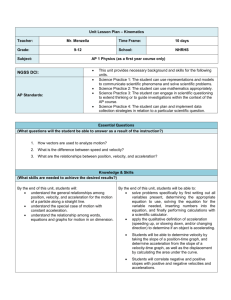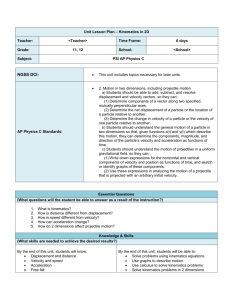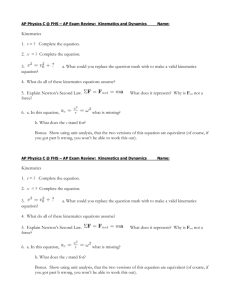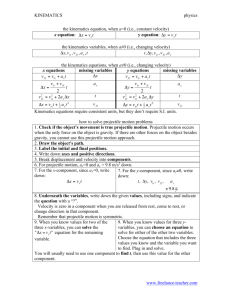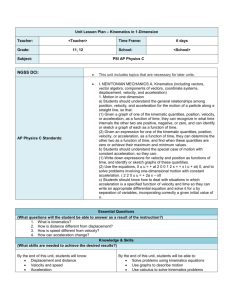Spring 2015, Math 111 Lab 4: Kinematics of Linear Motion
advertisement
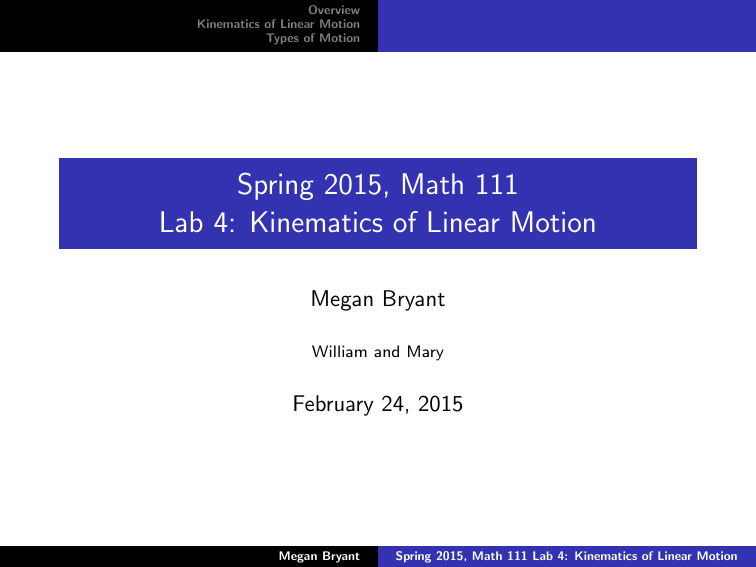
Overview Kinematics of Linear Motion Types of Motion Spring 2015, Math 111 Lab 4: Kinematics of Linear Motion Megan Bryant William and Mary February 24, 2015 Megan Bryant Spring 2015, Math 111 Lab 4: Kinematics of Linear Motion Overview Kinematics of Linear Motion Types of Motion Learning Objectives Today, we will be looking at applications of derivatives in the field of kinematics. Learning Objectives: I Interpret the first derivative of a position function I Interpret the first derivative of a velocity function I Relate the sign of velocity and position of an objection Megan Bryant Spring 2015, Math 111 Lab 4: Kinematics of Linear Motion Overview Kinematics of Linear Motion Types of Motion Kinematics Velocity versus Acceleration Kinematics of Linear Motion Definition Kinematics refers to the aspects of motion that arise from using calculus to connect the concepts of position (e.g. displacement), velocity and acceleration. Kinematics of Linear Motion is the study of particles, objects, or systems undergoing linear motion. Megan Bryant Spring 2015, Math 111 Lab 4: Kinematics of Linear Motion Overview Kinematics of Linear Motion Types of Motion Kinematics Velocity versus Acceleration Position Position is the location of an object with respect to its origin at a specific point in time. Its units are in length (e.g. meters, feet) Position is a vector. It has both magnitude and direction (i.e. 10 meters West of origin). Megan Bryant Spring 2015, Math 111 Lab 4: Kinematics of Linear Motion Overview Kinematics of Linear Motion Types of Motion Kinematics Velocity versus Acceleration Displacement Displacement is the resultant distance from a change in position. displacement = position1 − position2 Its units are in length (e.g. meters, feet) It is a vector and has both magnitude and direction (i.e. point b is 5 meters west of point a). Megan Bryant Spring 2015, Math 111 Lab 4: Kinematics of Linear Motion Overview Kinematics of Linear Motion Types of Motion Kinematics Velocity versus Acceleration Velocity Velocity is the rate of change of position. velocity = change in position change in time It is in units of length verus time (e.g. m/s, ft/s). Velocity is a vector. It has both magnitude and direction (i.e. 10m/s North). Megan Bryant Spring 2015, Math 111 Lab 4: Kinematics of Linear Motion Overview Kinematics of Linear Motion Types of Motion Kinematics Velocity versus Acceleration Acceleration Acceleration is the rate of change of distance. acceleration = distance change in time It is in units of length verus time (e.g. m/s, ft/s). Acceleration is a scalar. It has only magnitude, no direction (i.e. 10m/s). Megan Bryant Spring 2015, Math 111 Lab 4: Kinematics of Linear Motion Overview Kinematics of Linear Motion Types of Motion Kinematics Velocity versus Acceleration Velocity versus Acceleration It can be difficult to understand the relationship between velocity and acceleration. Acceleration Positive (+) Acceleration Negative (-) Velocity Positive (+) Object → “speeding up” Object → “slowing down” Velocity Negative (-) Object ← “slowing down” Object ← “speeding up” We can use this table to help us grasp how these two concepts interact. Megan Bryant Spring 2015, Math 111 Lab 4: Kinematics of Linear Motion Overview Kinematics of Linear Motion Types of Motion Kinematics Velocity versus Acceleration Kinematic Equations The following table summarizes the relationship between the three concepts. Concept Position Velocity Acceleration Equations s(t) v (t) a(t) s 0 (t) v 0 (t) s 00 (t) Given a position equation, you can utilize the derivative concept to find both the velocity and acceleration equations. Megan Bryant Spring 2015, Math 111 Lab 4: Kinematics of Linear Motion Overview Kinematics of Linear Motion Types of Motion Straight Motion Projectile Motion Types of Motion In this lab, we will study two types of motion. I Straight Motion in one dimension. I I I Uniform velocity Uniform acceleration Projectile Motion in two dimensions. I I Vertical component Horizontal component Megan Bryant Spring 2015, Math 111 Lab 4: Kinematics of Linear Motion Overview Kinematics of Linear Motion Types of Motion Straight Motion Projectile Motion Straight Motion The following path diagram is used to visualize the path of an object on a straight line path (an object with straight motion). The object is moving in one dimension (sliding back and forth). We visualize this by ’stacking’ the movement of the object in the diagram. Megan Bryant Spring 2015, Math 111 Lab 4: Kinematics of Linear Motion Overview Kinematics of Linear Motion Types of Motion Straight Motion Projectile Motion Straight Motion We see that from t = 0 to t = 3, the object is moving to the right of the starting position. Therefore, the velocity is positive in this interval. Megan Bryant Spring 2015, Math 111 Lab 4: Kinematics of Linear Motion Overview Kinematics of Linear Motion Types of Motion Straight Motion Projectile Motion Straight Motion At t = 3, the particle is changing directions. The object is moving neither left nor right. Therefore, the velocity is zero at time = 3 seconds. Megan Bryant Spring 2015, Math 111 Lab 4: Kinematics of Linear Motion Overview Kinematics of Linear Motion Types of Motion Straight Motion Projectile Motion Straight Motion How can we find the position of an object when it is at rest? We can solve v (t) = 0 to find times when the velocity is changing directions. At t = 3 when v (3) = 0, calculate s(3) to find the position at rest. Megan Bryant Spring 2015, Math 111 Lab 4: Kinematics of Linear Motion Overview Kinematics of Linear Motion Types of Motion Straight Motion Projectile Motion Straight Motion Now, the object has changed direction and is moving to the left. Therefore, the velocity is negative from t = 3 to t = 5. Megan Bryant Spring 2015, Math 111 Lab 4: Kinematics of Linear Motion Overview Kinematics of Linear Motion Types of Motion Straight Motion Projectile Motion Straight Motion At t = 5, again the particle is changing directions. The object is moving neither left nor right. Therefore, v (5) = 0 and s(5) = 5. Megan Bryant Spring 2015, Math 111 Lab 4: Kinematics of Linear Motion Overview Kinematics of Linear Motion Types of Motion Straight Motion Projectile Motion Straight Motion Finally, the object has changed direction and is again moving to the right. Therefore, the velocity is positive from t = 5 to t = 13. Megan Bryant Spring 2015, Math 111 Lab 4: Kinematics of Linear Motion Overview Kinematics of Linear Motion Types of Motion Straight Motion Projectile Motion Straight Motion How can we determine displacement over the first 5 seconds? Displacement is the total distance travelled, not relative distance. We need to account for distance travelled both forwards (→) and backwards (←). Megan Bryant Spring 2015, Math 111 Lab 4: Kinematics of Linear Motion Overview Kinematics of Linear Motion Types of Motion Straight Motion Projectile Motion Straight Motion We know that a change in direction happens at t = 3. This means we will have two distance intervals to calculate distance travelled in the interval t = 0 to t = 5. Distance = |s(0) − s(3)| + |s(3) − s(5)| Megan Bryant Spring 2015, Math 111 Lab 4: Kinematics of Linear Motion Overview Kinematics of Linear Motion Types of Motion Straight Motion Projectile Motion Distance Travelled The particle has travelled a total of 9 feet in the first 5 seconds. Distance = |s(0) − s(3)| + |s(3) − s(5)| = |4 − 9| + |9 − 5| = | − 5| + |4| = 9 feet Megan Bryant Spring 2015, Math 111 Lab 4: Kinematics of Linear Motion Overview Kinematics of Linear Motion Types of Motion Straight Motion Projectile Motion Displacement What is displacement? Displacement is change in position. Displacement = s(5) − s(0) =5−4 = 1 feet Megan Bryant Spring 2015, Math 111 Lab 4: Kinematics of Linear Motion Overview Kinematics of Linear Motion Types of Motion Straight Motion Projectile Motion An object with projectile motion has both a vertical (displacement) and a horizontal (time) component. Megan Bryant Spring 2015, Math 111 Lab 4: Kinematics of Linear Motion Overview Kinematics of Linear Motion Types of Motion Straight Motion Projectile Motion In a projectile motion graph, the velocity is zero when the object changes directions. Megan Bryant Spring 2015, Math 111 Lab 4: Kinematics of Linear Motion Overview Kinematics of Linear Motion Types of Motion Straight Motion Projectile Motion When v (a) = 0, the object will reach its maximum height. Megan Bryant Spring 2015, Math 111 Lab 4: Kinematics of Linear Motion Overview Kinematics of Linear Motion Types of Motion Straight Motion Projectile Motion Ending Notes Lab 4 is due next Tuesday, 3/3/2015 in class. I Proper derivative notation is required throughout the lab. I Work must be shown to receive credit. I Tutoring Monday night 5pm-8pm in Jones 112. These slides are available at www.meganrosebryant.com. Megan Bryant Spring 2015, Math 111 Lab 4: Kinematics of Linear Motion

